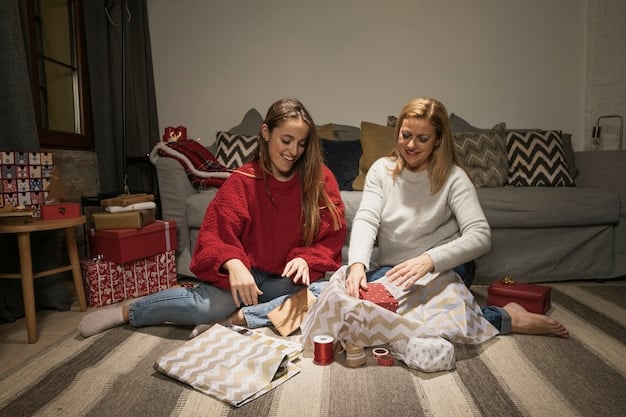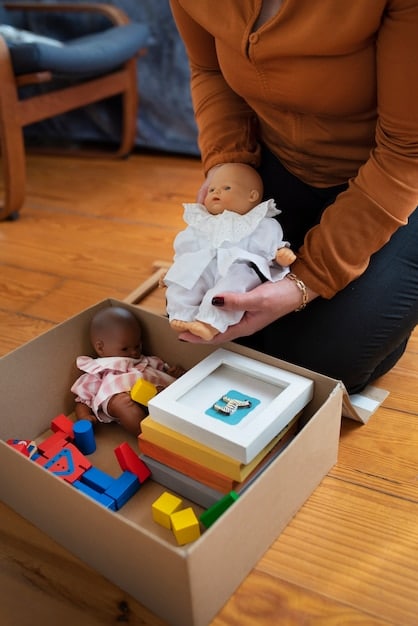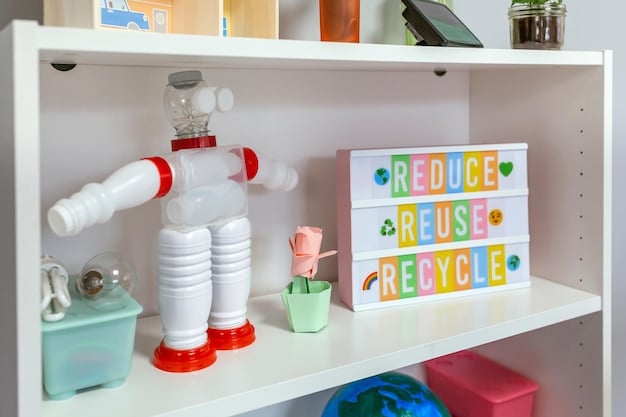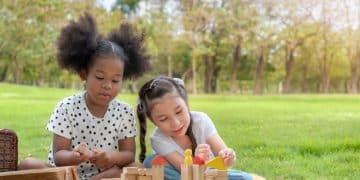Seasonal Toy Storage: Organizing Your Home After the Holidays in the US

Seasonal toy storage solutions are essential for maintaining an organized and clutter-free home after the holidays in the US, involving strategies such as decluttering, utilizing vertical space, and selecting appropriate storage containers to maximize space efficiency and reduce stress.
The holidays are over, and while the memories are sweet, the influx of new toys can quickly turn your home into a chaotic landscape. Seasonal toy storage solutions are crucial for regaining control and creating a peaceful, organized living space after the holiday season in the US.
Decluttering Before You Store: A Necessary First Step
Before even thinking about storage containers, it’s essential to take stock of what you have. Decluttering is the crucial first step in implementing effective seasonal toy storage, freeing up space and creating a more manageable environment.
Assess and Sort Toys
Begin by assessing all the toys. Gather everything into a central location to get a clear view of the volume you’re dealing with. Then, sort the toys into categories.
- Keep: These are the toys your children love and actively play with.
- Donate/Sell: Toys that are in good condition but no longer played with can find a new home.
- Repair: If a toy is broken but repairable, set it aside for fixing.
- Toss: Toys that are broken beyond repair should be discarded.

Involve Your Children in the Process
Making decluttering a collaborative effort can teach children about responsibility and generosity. It’s also a great way to understand their preferences and attachment to certain toys.
By decluttering effectively, you reduce the volume of toys that need to be stored, making the entire seasonal storage process much more manageable. It’s a win-win situation for both organization and peace of mind.
Maximize Vertical Space with Shelving and Wall-Mounted Solutions
In many homes, floor space is a precious commodity. This is where vertical storage solutions come into their own. By thinking upwards, you can create ample storage for seasonal toys without sacrificing valuable square footage.
Shelving Units
Shelving units are a versatile storage solution. Whether you opt for freestanding shelves or built-in options, they offer easy access and customizable configurations.
Wall-Mounted Baskets and Hooks
For smaller toys, consider wall-mounted baskets or hooks. These are especially useful for items like stuffed animals, small cars, or dress-up accessories.
- Baskets: Woven or wire baskets add a decorative touch while providing a secure place to store toys.
- Hooks: Perfect for hanging toy instruments, costumes, or even small toy organizers.
Vertical storage solutions are not just practical; they can also enhance the aesthetics of a room. By maximizing vertical space, you free up floor space, creating a more open and inviting environment.

Choosing the Right Storage Containers: Materials, Sizes, and Labels
Selecting the appropriate storage containers is vital for effective seasonal toy storage. The right containers not only protect your toys but also make it easier to find and access them when the season rolls around again.
Material Matters
Consider the materials of your storage containers. Plastic bins are durable and easy to clean, while fabric bins offer a softer, more decorative option.
Various Sizes
Choose a variety of sizes to accommodate different types of toys. Large bins are great for bulky items like stuffed animals, while smaller containers work well for LEGOs or action figures.
The Importance of Labels
Labels are your best friend when it comes to seasonal toy storage. Clearly label each container with its contents to avoid unnecessary rummaging.
Selecting the right storage containers, marked with detailed labels, streamlines the retrieval process when the desire for a specific set of toys comes back around. It’s an investment in future organization and reduces the likelihood of creating ‘search-and-rescue’ missions in your storage areas.
Rotate Toys to Keep Playtime Fresh and Engaging
One often-overlooked aspect of seasonal toy storage is toy rotation. Implementing a rotation system can significantly enhance children’s engagement with their toys and reduce clutter.
How Toy Rotation Works
Toy rotation involves storing away a portion of your child’s toys and bringing them out on a rotating basis. This keeps playtime fresh and exciting.
Benefits of Toy Rotation
The benefits of toy rotation are numerous. It reduces clutter, encourages creativity, and can even make children appreciate their toys more.
- Reduces Clutter: By storing away some toys, you create a more manageable play environment.
- Encourages Creativity: Children are more likely to engage deeply with a smaller selection of toys.
- Appreciation: When stored toys reappear, they feel new and exciting, rekindling interest.
By rotating toys, you provide your children with a continually refreshed play experience, keeping them engaged and excited. It’s a powerful tool for managing clutter and sparking creativity.
Creating Dedicated Zones: Playrooms, Closets, and Under-Bed Storage
Establishing designated areas for toy storage can make a significant difference in maintaining an organized home. Whether it’s a playroom, closet, or under-bed storage, having specific zones ensures that toys have a defined place.
Playrooms
If you have a dedicated playroom, make the most of it by incorporating shelving units, storage bins, and play mats.
Closets
Transforming closets into toy storage hubs can be a great way to keep toys out of sight. Utilize closet organizers, hanging shelves, and clear bins to maximize space.
Under-Bed Storage
Under-bed storage containers are perfect for storing larger items or seasonal toys.
By designating specific zones for toy storage, you create a structured system that promotes organization and reduces clutter throughout your home. It’s a foundational strategy for maintaining an orderly living environment.
DIY Toy Storage Solutions: Creative and Cost-Effective Ideas
For those who love a personal touch, DIY toy storage solutions offer an affordable and creative way to keep toys organized. With a bit of imagination and some basic materials, you can create storage solutions that perfectly fit your space and style.
Repurposed Furniture
Transform old furniture into charming toy storage solutions. An old bookshelf can become a toy shelf, or a repurposed dresser can serve as a LEGO station.
Hanging Shoe Organizers
Hanging shoe organizers are not just for shoes. They can be used to store small toys like action figures, craft supplies, or even doll accessories.
Cardboard Box Creations
Don’t underestimate the power of cardboard boxes. With some paint and creativity, they can be transformed into colorful and functional storage bins.
Engaging in DIY toy storage projects is an enriching way to integrate personalization and practicality. It caters to those who seek to add a custom flair to their organizational efforts, aligning storage solutions with their decor while staying budget-conscious.
Maintaining the System: Regular Purges and Organization Habits
The key to long-term success with seasonal toy storage is maintaining the system. Regular purges and organization habits are crucial for preventing clutter from accumulating again.
Schedule Regular Purges
Set aside time every few months to go through your toy storage. Remove items that are no longer used or needed.
Establish Organization Habits
Encourage your children to participate in the organization process. Make it a habit to put toys away after playtime.
- Daily Tidy-Up: Spend a few minutes each day tidying up toys.
- Weekly Organization: Dedicate a few minutes each week to a more thorough organization session.
Maintaining a seasonal toy storage system is an ongoing process that requires commitment. A consistent approach to decluttering and organizing ensures that your home remains clutter-free and organized year-round.
| Key Point | Brief Description |
|---|---|
| 🧸 Declutter First | Sort toys to keep, donate, repair, or toss before storing. |
| ⬆️ Vertical Space | Use shelves and wall mounts for space-saving storage. |
| 🗂️ Label Bins | Clearly label storage containers to easily find toys. |
| 🔄 Rotate Toys | Swap toy selections to keep play fresh. |
Frequently Asked Questions
▼
The first step is decluttering. Go through all the toys and decide which ones to keep, donate, repair, or toss to reduce the amount that needs to be stored.
▼
Labeling helps you easily identify the contents of each container without having to open them, saving time and keeping the storage area organized and efficient.
▼
Involve your children by asking for their input on which toys to donate and letting them help sort toys into labeled bins. This teaches responsibility.
▼
DIY options like repurposing old furniture, using hanging shoe organizers, and decorating cardboard boxes are cost-effective alternatives for toy storage.
▼
It is recommended to purge and reorganize toys every few months or at least twice a year, typically before holidays or seasonal changes to manage clutter effectively.
Conclusion
Implementing these seasonal toy storage solutions can transform your home from a post-holiday disaster zone to an organized and peaceful living space. Remember, the key is to declutter, utilize space wisely, and maintain consistent organization habits. By taking these steps, you’ll be well-prepared to tackle the toy influx and enjoy a clutter-free home year-round.





